"Taking
Aachen" |
 |
|
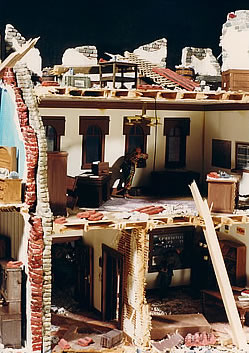 | 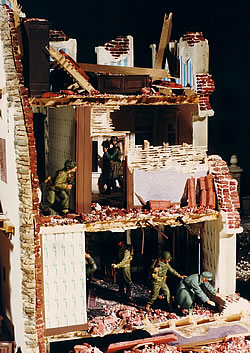 |
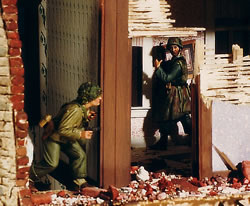 I
wanted this diorama to be visually compelling from any angle, not just from the
front. That meant serious detailing of the interiors: flooring, beds, tables,
bathroom fixtures, etc. I scratchbuilt a refrigerated meat display case and shelving
for the butcher shop; magazine shelves for the tobacco shop; file cabinets with
open drawers and schedule board for the second floor "Boschert Buro";
and miniature scale building plans and file cabinets for the architect's office.
The interior wall of the church was detailed with Verlinden's self-adhesive "marble"
paper and stained glass windows, and additional woodwork made from plastic card.
I
wanted this diorama to be visually compelling from any angle, not just from the
front. That meant serious detailing of the interiors: flooring, beds, tables,
bathroom fixtures, etc. I scratchbuilt a refrigerated meat display case and shelving
for the butcher shop; magazine shelves for the tobacco shop; file cabinets with
open drawers and schedule board for the second floor "Boschert Buro";
and miniature scale building plans and file cabinets for the architect's office.
The interior wall of the church was detailed with Verlinden's self-adhesive "marble"
paper and stained glass windows, and additional woodwork made from plastic card.
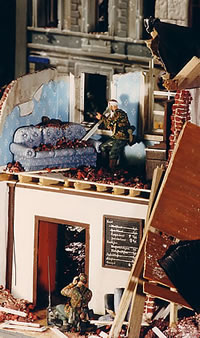 One
of the most challenging aspects was building the staircase for the corner house,
which led both to the second floor as well as down to the basement, from which
the captured German soldiers emerge. The second floor was a good place to put
Verlinden's bathroom furniture set (#946), and set the stage for an interesting
confrontation between one of the GI's and a sniper.
One
of the most challenging aspects was building the staircase for the corner house,
which led both to the second floor as well as down to the basement, from which
the captured German soldiers emerge. The second floor was a good place to put
Verlinden's bathroom furniture set (#946), and set the stage for an interesting
confrontation between one of the GI's and a sniper.
There's
a considerable amount of work involved dressing these buildings. While the two
Verlinden city houses came with resin window frames, both the frames and the window
openings had to be cleaned up so they would mate correctly. Other windows had
to be framed and trimmed with plastic stock. Curtains came from Hudson & Allen,
as did several pieces of exposed plumbing.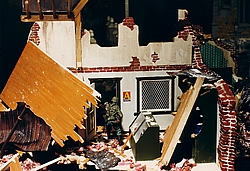
Since
the buildings were demolished, it was necessary to create the attendant debris:
rubble of brick, stone, joists, beams and flooring. I build several broken sections
of wall, with framing, lathe, and plaster, and similar representations of destroyed
roofing.
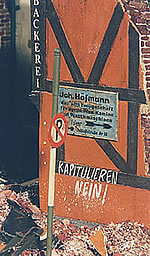 The
interiors and exteriors of the buildings were dressed with appropriate signage.
I got translations of various bakery items for the blackboard on the wall above
the radio operator, and estimates of what the prices would likely have been in
the fall of 1944 - if they were available at all. One interesting detail I lifted
from After the Battle was the lurking black figure, outlined in white, which was
painted on city walls with the warning "Feind hört mit!"
(roughly, enemies are amongst us). Using such historical artifacts lend a greater
sense of realism to the diorama setting.
The
interiors and exteriors of the buildings were dressed with appropriate signage.
I got translations of various bakery items for the blackboard on the wall above
the radio operator, and estimates of what the prices would likely have been in
the fall of 1944 - if they were available at all. One interesting detail I lifted
from After the Battle was the lurking black figure, outlined in white, which was
painted on city walls with the warning "Feind hört mit!"
(roughly, enemies are amongst us). Using such historical artifacts lend a greater
sense of realism to the diorama setting.
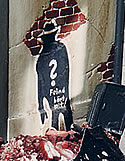
"Taking
Aachen"
The Battle for Aachen
Evolution
of the Diorama
The City
Vehicles
and Gun
The Figures
References
 |
 |
 |
 |
 |
 |
 |
 |
 |
 |
 |
 |
|